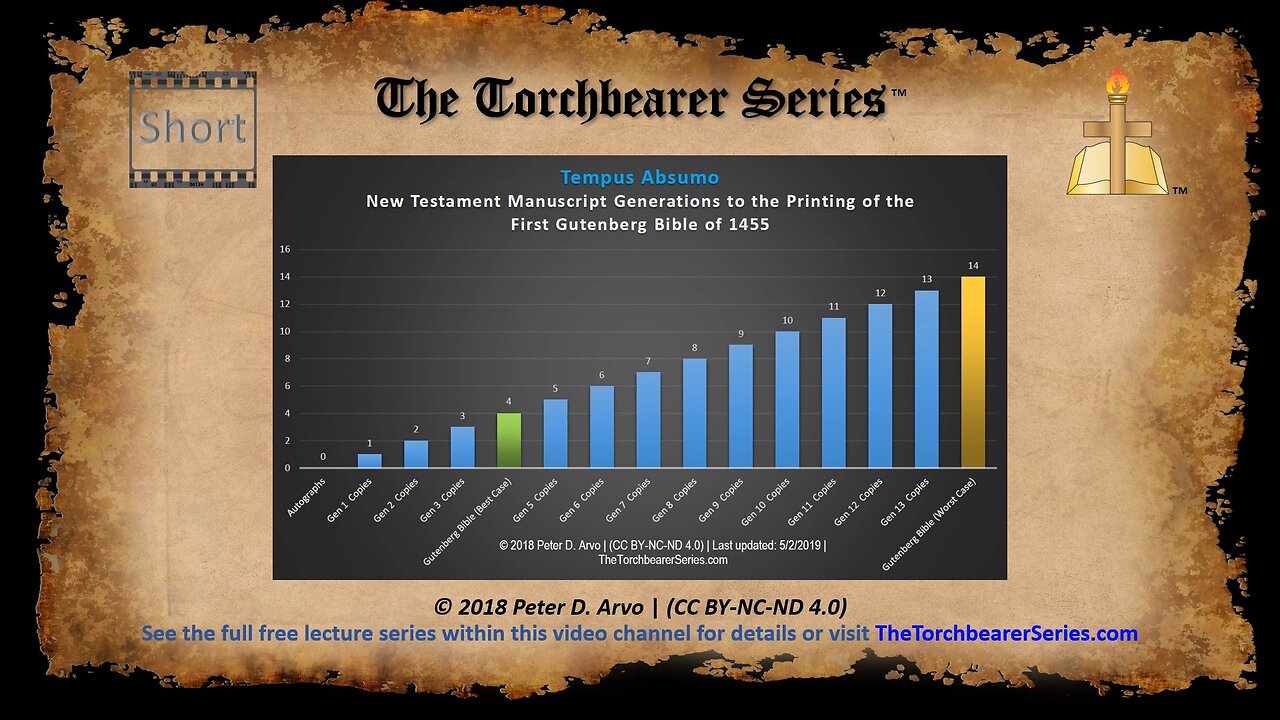Premium Only Content

Short PB - Tempus Absumo Chart
Understanding the new information on how long manuscripts last, including how long biblical manuscripts are usable, is a very important topic. The following is from the well-researched and referenced Core Course B501: Session 1 of 3 Supplemental Lecture Notes from The Torchbearer Series. Most references are not provided within this video description as a result of space limitations. Please see the following direct link to the lecture notes or visit TheTorchbearerSereis.com website: https://www.thetorchbearerseries.com/lecture-notes/B501%20Manuscript%20History%20-%20Session%201%20of%203.pdf
Tempus Absumo means time before destruction.
Tempus Absumo is pronounced: Temp·pus Ab·soo·moe.
Tempus Absumo is Latin for ‘Time before Destruction or Annihilation’.
Tempus = time, season, moment, period. Absumo = destroy, annihilate, ruin, consume, use, waste.
Absumo = destroy, annihilate, ruin, consume, use, waste.
Abbreviations Staff. “Tempus Absumo.” STANDS4 LLC. 2019. https://web.archive.org/web/20190606200108/https://www.abbreviations.com/term/2072536
Papyrus Tempus Absumo: The following is an excerpt from research published in the field of papyrus tempus absumo in 2014 about the average lifespan of manuscripts; in which literary works, correspondence, notes, and commentaries were dated, which have often made it possible in many cases to determine when manuscripts were copied, and how long they were in use before being replaced, discarded, or destroyed. “How long did a papyrus roll last? The evidence from our collections indicates that a usable lifetime of about 100 to 125 years was common and can reasonably be considered the norm; a small but significant number of manuscripts were still usable some 300 years after they were first created; and on rare occasions a manuscript might last, it seems, for half a millennium (3.9 and 4.13).” – Professor George W. Houston, Ph.D.
Parchment Tempus Absumo: New Testament manuscript autographs (originals) would have likely used parchment, not papyrus, “The cloke that I left at Troas with Carpus, when thou comest, bring with thee, and the books, but especially the parchments.” – 2 Timothy 4:13 (KJV) Since most of the New Testament writers were Jewish, they would have been aware of the rule of only writing sacred text on clean animal skin (parchment). Parchment is stronger, more stable, and lasts longer than papyrus. So we can expect to get at least the same, or better, Tempus Absumo results with parchment vs papyrus.
Manuscript Tempus Absumo: It is noteworthy to mention, that according to the Worcester Cathedral Library “Vellum [parchment] has proven to last over a thousand years in excellent condition; however, it can be very vulnerable to changes in humidity, which causes pages to buckle. Books with parchment pages were bound with strong wooden boards and were clamped shut by metal clasps or leather straps in order to keep the pages pressed flat.” Parchment is considered so durable that it was used for the most important legal documents in the United Kingdom, at least until October 12th, 2015, when the Commons Committee voted in favor of scrapping vellum [parchment] as the material on which Acts of Parliament are printed, and instead adopted the use of a modern high-quality acid-free long-lasting paper.
So why is this new Tempus Absumo information important? Because it was previously thought by some scholars that papyrus manuscripts would only last around 20 years, which would have required far more hand copying to occur until the first printing press Bible could be produced in 1455, the Gutenberg Bible. If we take the earliest time that a document could have been written of Christ’s ministry in 27 A.D., and subtract that from 1455, we have at most 1,428 years of hand-copying.
This means if we go from the time of Christ’s ministry to the time of 1455, we would have an estimated 3 generations of copies for the best-case scenario for papyrus (shown in green on the Tempus Absumo diagram) and in the worst-case scenario 14 generations of copies for papyrus (shown in yellow on the Tempus Absumo diagram).
Hopefully, this short video description has helped answer the following questions. Some of the differences between Papyrus Tempus Absumo versus Parchment Tempus Absumo. Which last longer Papyrus or Parchment? Why is Tempus Absumo important? Which is more resilient to environmental conditions Parchment or Papyrus? Did the Apostles write on Parchment or Papyrus? Later, what did the followers of Jesus use to write on Papyrus or Parchment? How long did a papyrus last? How long did a Parchment last?
For the full details and the references that you can very easily check out for yourself and share, re-post, link to, print, and handout, please see https://www.thetorchbearerseries.com/pb.html. Many free Bible charts, diagrams, and documents are also available.
Watch the full lecture series here: https://www.youtube.com/watch?v=UBG2q_3KGus&list=PL0qwkdBdTcQ9r4QG2XyrqCSDo9l9b0t3Z&index=1
-
 LIVE
LIVE
Man in America
5 hours agoMAHA Feels Betrayed by RFK Jr.—What's REALLY Happening? w/ Sayer Ji
1,324 watching -
 LIVE
LIVE
Savanah Hernandez
3 hours agoToxic Empathy Is Ruining America
2,177 watching -
 1:39
1:39
Stephen Gardner
6 hours ago🚨BREAKING: Karoline Leavitt MAKES STUNNING announcement about Trump's Assassin!
16.1K10 -
 1:32:10
1:32:10
Joker Effect
1 hour agoRumble is about to get a new genre!! Are you ready to take it on? Time to fight fire with fire!
14.2K -
 LIVE
LIVE
SilverFox
1 hour ago🔴LIVE - ELDEN RING - ZERO DEATH CHALLENGE - ATTEMPT 5
360 watching -
 17:17
17:17
SantaSurfing
4 hours ago4/8/2025 - Modern Day Wealth Managers! The Rewards of planning and dreaming big!
8.83K16 -
 26:40
26:40
Producer Michael
8 hours agoI WAS ROBBED IN MY NEW HOUSE!
9.59K1 -
 13:00
13:00
SKAP ATTACK
4 hours ago $0.26 earnedMichael Malone FIRED by Nuggets
4.7K1 -
 1:11:45
1:11:45
NucleoNick
1 day ago🟢LIVE NOW! The Legend of Zelda: Skyward Sword - Part 8🟢
2.62K -
 1:28:14
1:28:14
Slightly Offensive
2 hours ago $4.25 earnedShould THEY Be Able to Use SELF-CHECKOUT? | Guest: Hermes
17.5K3